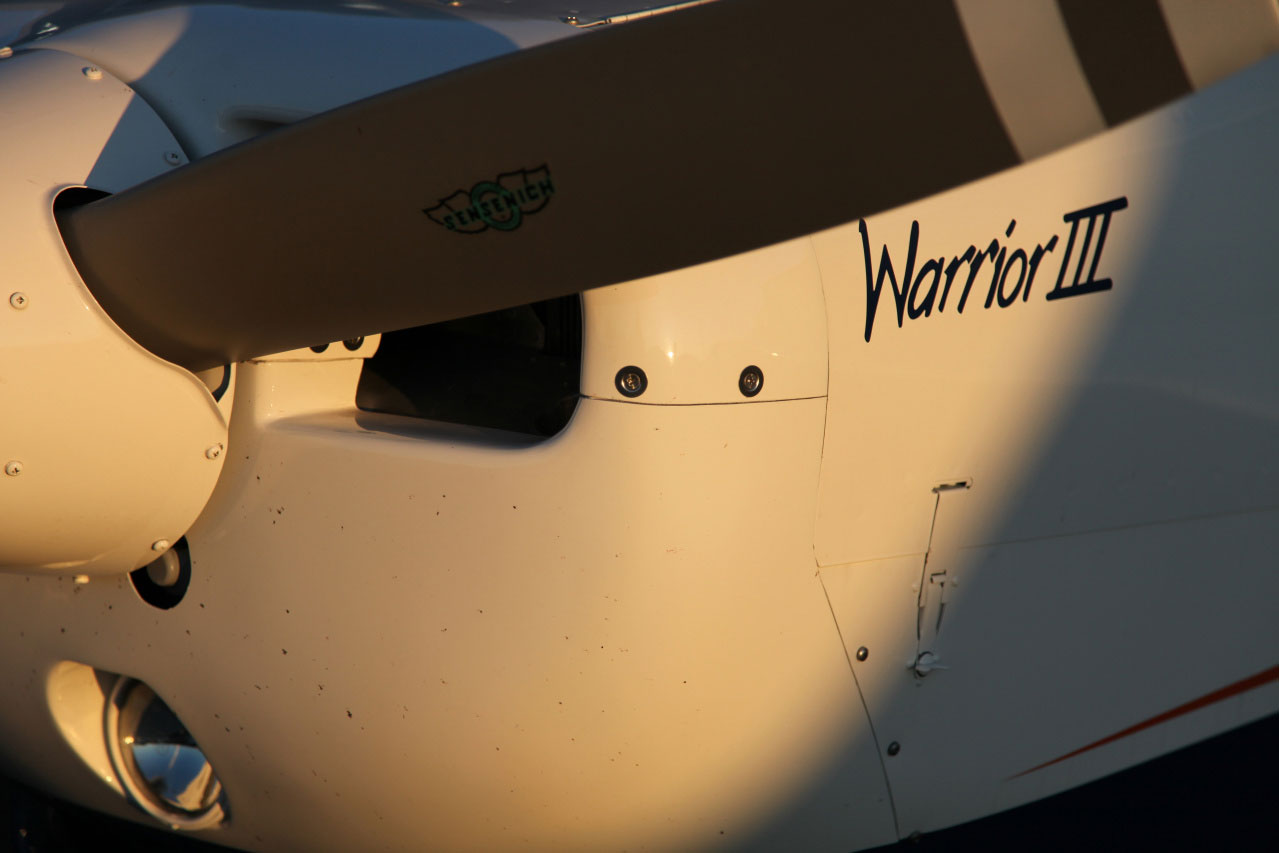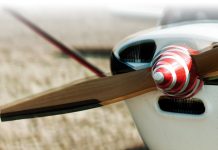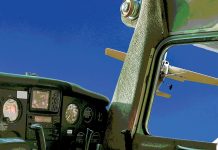Pilot Michael Ralph’s graphic retelling of an all-too-common VFR occurrence. On 29 July 2007, a Piper Warrior flown by a VFR pilot, with three people on board, entered cloud – without an autopilot. Against the odds they survived.
Michael (C182 pilot): I organised a weekend flyaway for our aero club from Moorabbin to Echuca for the Winter Blues Festival. Our party included my wife Merryn and I, and two friends – John and Sandra, in a Cessna 182; and Dave, his wife Molly and Kate (revalidating a lapsed VFR licence), in the Piper. Sunday’s weather for our departure from Echuca was low cloud and drizzle. I was one of the last to depart, after thanking our hosts and performing thorough pre-flight checks on the C182.
Dave (Warrior pilot): Molly sat in the back and Kate sat beside me to get some experience. We took off after lunch, intending to return to Moorabbin via the Kilmore Gap, and found scattered, scrappy clouds at 900’ AMSL. We pressed on but conditions worsened, even though others had made it through. I didn’t like the conditions and returned to Echuca, landing at 2:00pm. I decided to put some more fuel into my tanks, having used about half an hour’s worth in the aborted attempt to fly home and in case we had to divert on our next attempt.
Michael: Seeing Dave taxi over to the bowser prompted me to do the same. As it turned out, I didn’t need to, but Dave’s precaution was a major factor in their survival.
Dave: Michael and I decided we would stay overnight in Echuca. We began tying the aircraft down for the night. A local pilot said that it was OK at Ballarat and Bendigo, and after my first attempt to fly towards Mangalore with a 600’ AGL cloud-base, 1,200’ at Bendigo seemed attractive.
Michael: It was clear at Moorabbin, with scattered clouds at 5,000’. Dave wanted to fly via Bendigo and approach Melbourne from the west. Since there was a stratus layer over Victoria north of the Great Dividing Range, I thought that the cloud-base would be the same height AMSL at Bendigo as at the Kilmore Gap, but the ground would be higher to the west; we should fly through the Gap. We agreed that we would fly in company and assess the situation in the air. Plan A would see us head south for the Kilmore Gap, Plan B would see us head for Bendigo, and Plan C would see us land back at Echuca and stay overnight after all. The C182 is faster than the Warrior, so I would have to slow down.
John: I thought we had agreed to try for Bendigo first.
Michael: No! I’m convinced that we were going to try for the Gap. However, since we didn’t state which frequency we would have our conference on – CTAF, area or company – and Dave took off before we were ready. I concede that we did not plan very well. Dave started up and taxied away while we were still loading and pre-flighting our plane.
We lifted off at 4:00pm and climbed to 850’ AMSL. Ten minutes into the flight, I heard Dave faintly calling me on the radio. I responded twice but he didn’t call again. Presuming he was ahead of us on the same track, I didn’t see an urgent need to establish radio contact. Entering the Kilmore Gap, I called Melbourne Radar to request flight-following. Although the overcast made the scene rather gloomy, we transited the Gap safely through to Kilmore and flew back to Moorabbin.
We taxied to our parking bay and shut down. As we climbed out another pilot, Ken, emerged from Ops and called me over. ‘Have you heard from Dave?’ he asked. ‘John rang Kate ten minutes ago, why?’ I replied. ‘We’ve just heard from Melbourne Radar that they have flown into cloud and requested assistance,’ Ken said. ‘No more has been heard from them so Melbourne Radar called Ops to ask about the plane’s equipment and the pilot’s qualifications.’
We knew the implications: researchers at the University of Illinois tested 20 non-instrument-rated pilots in simulators to see how long they could fly on instruments after losing visual references outside of the cockpit. Time intervals ranged from 20 to 480 seconds. The average time interval before they lost control was 178 seconds … not quite three minutes.
I rang Dave’s mobile: it went to voicemail. I rang Kate’s mobile: it went to voicemail. For the next thirty minutes, I thought Dave had confirmed these statistics.
Merryn: I’ve never seen Michael look like that … ‘haunted’ is how I’d describe it.
Michael: Sick with worry, I helped the others secure the C182, and then we entered the Ops building. The instructors on duty were subdued. The club president asked me for any information. People were clustered around the radio. Then we heard Melbourne Centre talking with Dave, who was now on top of the cloud at 10,500’ AMSL. He was alive, but still in trouble. I couldn’t stand; I sat on the carpet beside the radio and prayed silently.
Dave: We left without Michael because his aircraft was 30 knots faster, so he should have been able to catch up. Molly was anxious about flying in this weather and I was concerned that last light was a few minutes prior to 6:00pm. Also, the weather at Bendigo might worsen if we delayed, so I planned a track to the west of Bendigo and Ballarat. There were patches of low cloud and we cruised between 1,100’ and 1,300’ AMSL from Echuca to the west of Bendigo.
Kate: I guess we were about 20 minutes into the flight when I started feeling uneasy.
Dave: I called Michael, but did not receive a response. The conditions were worsening, but it seemed to be brighter further west. About ten miles south of Bendigo I could see showers rolling through so I turned north, asking Kate to set the ADF to track to the Bendigo NDB. As we progressed, the cloud base seemed to be lowering. In hindsight, I can see that the ground was rising beneath us and, as I tried to maintain my ground clearance, I was inadvertently climbing towards the cloud. I decided to try to land at Bendigo.
Kate: The GPS suddenly began warning us of terrain ahead. There were no obstacles – we must be really low. My chest started to feel tight. As I pored over the map, I noted a large hill to the south of Bendigo; it was at least 1,000ft above our current altitude! Where was Bendigo? I couldn’t see it on the GPS.
Dave: As we approached Bendigo again there were showers passing through, but we could see the town. I couldn’t reverse course without entering cloud. I began circling, only a few hundred feet above hilly, tree-covered ground, looking for a break to duck through. We were in trouble.
I contacted Melbourne Centre and advised them that I needed help as cloud was beginning to surround us. With visibility worsening, I made the decision to level my wings and climb away from the terrain, knowing that this would take us into cloud. It was the hardest decision of my life, but I believed that staying where we were, with showers obscuring our visibility in such close proximity to the ground, was perilous.
Mike (ATC): A call came from a VFR pilot requesting assistance. I asked him to stand by while I dealt with another flight. When I returned to him, he was already in cloud. My heart pounded as I turned to my supervisor, ‘I’ve got an emergency’.
Kate: The disorientation as we entered the cloud was overwhelming, and I felt the aircraft lurching as Dave fought to keep control. I thought of my two young boys, blissfully ignorant of my predicament. My heart ached at the thought that I would never see them again.
Molly: I knew we were in trouble when I heard Dave swear: he never swears! I didn’t want to see the end coming, but I didn’t scream or cry because I knew that Dave needed to concentrate. I thought of the new will which I had neglected to sign the previous day.
Dave: When we entered the clouds I became immediately disoriented as I ‘chased the needles’. For a moment I thought we’d had it. I knew the statistics, but was grimly determined not to validate them. Everything they tell you about flying into cloud is true. My senses were totally confused. The nose is too high. Put the stick forward. Turn the carby heat off. Retract the flaps – in stages. I began monitoring the ASI, AH, VSI and DG. Once I stabilised the climb, I radioed the controller again. As I recall, the ensuing conversation with Melbourne Centre went something like this:
MLB CTR: Are you in cloud?
Dave: Affirmative.
MLB CTR: Are you instrument-rated?
Dave: Negative.
MLB CTR: Keep your wings level and trust your instruments. Are you night-rated?
Dave: Negative.
MLB CTR: Do you have an auto-pilot?
Dave: Negative.
MLB CTR: How many POB?
Dave: Three people.
MLB CTR: What is your fuel status?
Dave: Fuel is OK. About four hours’ endurance.
Thank God I had taken on more fuel in Echuca. Prior to refuelling we had only enough for the 75-minute flight plus 45 minutes in reserve. Our flight was to last two and a half hours.
Mike: We have a checklist for handling a VFR into IMC emergency. I enlisted Dennis to take over all other traffic in my sector to another frequency and my supervisor contacted AusSAR who scrambled an emergency helicopter. I called Susie over to assist because she has a private pilot’s licence. She began to examine the WAC chart to check the lowest safe altitude.
Dennis (ATC): That day was one of the worst I’ve had in my 15 years as an ATC. I thought I was going to witness a crash. It was a classic nightmare situation for a VFR pilot, one which has ended more than a few lives.
Flying into cloud without instruments (or without knowing how to use them) is incredibly dangerous. It’s almost inevitable you’ll lose control of the aircraft within a few minutes and crash, as without visual reference to the horizon you can’t tell if the aircraft is turning or flying with level wings. If movements are gentle, they don’t register with your senses – a wing could be gradually dropping and you don’t realise until it’s too late. Or you do realise, over-correct and lose control that way.
Kate: I gazed out of the window at the whiteness. It hurt my eyes. Whilst our deaths no longer appeared to be imminent, we were a long way from safety. As we climbed through the clouds, we had periodic contact with the ATC who was confirming our position and trying to establish when we broke through. I wished that he would talk more often. His calm voice made me feel less alone. Finally, we emerged into clear air at about 5,000’. Whilst we could now see, it was of little comfort. There was solid cloud above and below our little aircraft.
Michael (C182): Climbing from 1,000’ to 5,000’ at 500 feet per minute would take eight minutes … considerably more than 178 seconds.
Mike (ATC): Another controller entered a flight data record into the Eurocat system with a discrete code so I could maintain the correct identification of the aircraft’s radar paint even if he temporarily dropped off and returned to radar. Eventually the pilot, sounding surprisingly calm, reported that he was on top of the cloud.
Dave: ‘We’re into clear air.’
Mike: ‘Good. Can you see any holes?’ Andy had found out that the aircraft was a Warrior and part of a fly-away. He contacted the aero club to gather more information about the plane, the people on board and their flying experience. He had also obtained reports that there breaks in the cloud at Bridgewater which is 15nm NW of Bendigo. I discussed this with the pilot and he decided to track that way.
Dave: I asked whether we could be vectored towards the coast and descend over Port Phillip Bay.
Mike: He reported that he couldn’t find any breaks in the cloud. I suggested that I provide radar vectors to Ballarat, and then further south toward the coast where we hoped the cloud would clear. We then planned to turn him east across the bay to Moorabbin.
Dave: Melbourne Centre asked how I felt about descending through cloud, but I really didn’t have a choice. They suggested getting us overhead the airfield at Mangalore and making descending orbits, turning through the cloud. I rejected the option: ‘No – no turns!’ I felt that I would have a much more controllable descent with my wings level and descending at 500 feet per minute. The controller agreed and suggested Shepparton. That was better because I am familiar with that airfield and getting there wouldn’t involve turns in cloud.
We couldn’t take up the heading we were given for Shepparton at the level we were at without entering cloud again, so we found a hole and climbed above the next layer of cloud. We were on top by 9,500’ AMSL although, as we tracked towards Shepparton, the cloud tops rose and we had to climb to 10,500’ to stay clear. The little Warrior didn’t climb as well at that altitude as it does at sea level; the climb took ages.
Kate: The enormity of what was happening hit me when I heard that passenger jets were being asked to look for holes in the cloud for us, anywhere between Sydney and Melbourne. Dave pointed our aircraft into the opening in the cloud and we climbed steadily. At one point we re-entered the cloud and he had to descend and reverse course to get us out. We passed 7,500’, 8,000’, 9,000’ … I was screaming inside: ‘How much longer?’ We were finally clear at 9,500’.
Dave: The controller calculated that we should commence our descent immediately. We re-entered the cloud (the second-hardest decision of my life) and I tried to keep the wings level, monitoring the air speed and rate of descent. A couple of times I was asked to turn to the right as we had started a slight left-hand turn. ATC again reminded us of the fast-disappearing daylight. I would have loved to increase RPM and descend more quickly, but I didn’t want to risk getting out of control.
Mike: The pilot wanted to descend straight ahead at 500 fpm, which he was now top of descent. Next call he was on descent and back in cloud. Within a few seconds the radar paint began a slow left turn. I let him know, and he straightened up but he was now tracking to the west of Shepparton. I decided not to say too much and just let him keep it level.
Michael (C182): They were just about to commence their descent when Ops patched into the frequency and discovered that Dave, Molly and Kate were still alive … so far. We listened to the conversation as they descended. Whilst the controller couldn’t see Dave’s instruments, he could see their projected track changing 40 deg ~ 50 deg to the left and warn them: ‘You’re turning. Lift your left wing’.
The controller was impressive: so calm, so reassuring. It seemed like he was guiding Dave on a walk in the park. At last we heard Dave call the controller: ‘We’re clear! We can see the ground!’
I felt like crying with relief.
Dave: We broke through the cloud near Waranga Basin at about 2,800’ AMSL. I descended to about 2,000’, but there were still cloud patches, so I continued the descent to 1,500’. We had about ten minutes to run to Shepparton, and it was already quite dark with all that cloud above us. Melbourne Centre advised that the wind was 050 degrees magnetic, so I replied I would fly a straight-in approach to runway 36. I’d only get one go and then it would be pitch-black.
Mike (ATC): The pilot reported: ‘I can see the ground!’ The relief for us was overwhelming. He was flying through the scud at the base of the cloud. I looked at the map to assist him identify his surroundings, and then gave him the distance and direction to the aerodrome.
Dave: We approached the airfield, and I advised Melbourne Centre that I was lined up on final. The controller asked me to advise when we were safely on the ground, and the emergency helicopter would relay the message. It was so dark I could hardly see the instrument panel. I didn’t know how to turn on the panel lights.
Michael (C182 pilot): We were listening: ‘He’s in the circuit … on final … they’ve landed.’ We began clapping softly and exhaling long sighs. We were too drained to cheer.
Mike (ATC): Within a few moments, I heard the happiest SAR cancellation of my career.
Dave: We landed safely and taxied off the runway at about 5:50pm local time. End of daylight was five minutes later, officially, but with the heavy overcast it was already pretty dark.
Kate: I don’t know how, but Dave managed a textbook landing, and we taxied gratefully to the club house. My legs almost collapsed as we alighted, and I wanted to kiss the ground. The relief as we entered the building was too much to contain for Molly and me. We cried and hugged as Dave moved the aircraft to the visitor parking area.
Dave: ATC had been in touch with the Shepparton Aero Club. They asked me to call ATC who admitted: ‘We were very worried about you!’ They weren’t the only ones!
Dennis: Huge sighs of relief all around, believe me. Airservices provided counselling for all of us the next day. I needed a bit of a break myself as once I’d ‘wound down’; I was quite emotional when I’d had time to think about it. I was pretty close to tears – it’s not every day you fear for someone’s life for an extended period and can’t do a whole lot about it.
Michael: (C182): Any inconsistencies between my version, Dave’s version, Kate’s version and those of Dennis and Mike are as a result of what happens when people recount their personal memories of a shared event. After two and a half hours of nightmare flying, I’m just glad that Dave is here to argue the finer points. I’d like to express my heartfelt thanks to Mike, Susie and Dennis for their guardianship of my friends.
Dave: By asking for help, I had ATC looking out for me. All I had to do was fly the plane and go where I was told. Their alerting me to the start of my graveyard spirals before I lost control was incredibly valuable.
Michael: Back at home, I felt very unsettled when I uploaded the weekend’s photographs from my camera and looked at the picture of the three of them smiling at me on Saturday. That photo could have been on the front pages that week.
Dennis: I’ve been involved in other emergencies, but this one has affected me most. I guess because it took an hour and a half, there was danger the whole time and we had input. Something we said or did could have influenced whether the pilot lived or died.
In situations like this the final call belongs to the pilot – we can’t fly the plane for them, even if we are pilots, which I’m not. Even if it has a successful outcome it doesn’t stop me feeling very responsible for what happened. Could I have done more or better? The point is to learn from the experience.
*Reprinted with permission from Australian Flying who first published the story in Jan/Feb 2008.
Have you had a close call? Write to us about an aviation incident or accident that you have been involved in (as long as it’s not the subject of a current official investigation). If we publish your story, you will receive $500. Articles should be between 450 and 1400 words. Submit your close call by emailing fsa@casa.gov.au and your story could be published like this one and others in our close calls collection.






Comments are closed.